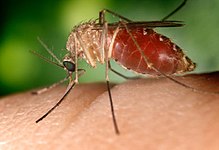WNV is one of the
Japanese encephalitis antigenic
serocomplex of viruses. Image reconstructions and
cryoelectron microscopy reveal a 45–50 nm
virion covered with a relatively smooth
protein surface. This structure is similar to the
dengue fever virus; both belong to the genus
Flavivirus within the family
Flaviviridae. The genetic material of WNV is a
positive-sense, single strand of
RNA, which is between 11,000 and 12,000
nucleotides long; these
genes encode seven nonstructural proteins and three structural proteins. The RNA strand is held within a nucleocapsid formed from 12-
kDa protein blocks; the capsid is contained within a host-derived
membrane altered by two viral
glycoproteins.
Phylogeny
Studies of
phylogenetic lineages determined WNV emerged as a distinct virus around 1000 years ago.
[22]
This initial virus developed into two distinct lineages, lineage 1 and
its multiple profiles is the source of the epidemic transmission in
Africa and throughout the world. Lineage 2 was considered an Africa
zoonosis.
However, in 2008, lineage 2, previously only seen in horses in
sub-Saharan Africa and Madagascar, began to appear in horses in Europe,
where the first known outbreak affected 18 animals in Hungary in 2008.
[23] Lineage 1 West Nile virus was detected in South Africa in 2010 in a
mare and her aborted
fetus; previously, only lineage 2 West Nile virus had been detected in horses and humans in South Africa.
[24] A 2007 fatal case in a
killer whale in
Texas broadened the known
host range of West Nile virus to include
cetaceans.
[25]
The United States virus was very closely related to a lineage 1
strain found in Israel in 1998. Since the first North American cases in
1999, the virus has been reported throughout the United States, Canada,
Mexico, the Caribbean, and Central America. There have been human cases
and equine cases, and many birds are infected. The
Barbary macaque,
Macaca sylvanus, was the first nonhuman
primate to contract WNV.
[26]
Both the United States and Israeli strains are marked by high mortality
rates in infected avian populations; the presence of dead
birds—especially
Corvidae—can be an early indicator of the arrival of the virus.
Transmission
West Nile virus maintains itself in nature by cycling between mosquitoes
in the genus Culex and certain species of birds. A mosquito (the
vector) bites an uninfected bird (the
host),
the virus amplifies within the bird, an uninfected mosquito bites the
bird and is in turn infected. Other species such as humans and horses
are incidental infections, because the virus does not amplify well
within these species and they are considered dead-end hosts.
West Nile virus (WNV) is transmitted through female mosquitoes, which are the prime
vectors of the virus. Only females feed on blood, and different species take a
blood meal from different types of
vertebrate hosts. The important mosquito vectors vary according to geographical area; in the United States,
Culex pipiens (Eastern United States, and urban and residential areas of the United States north of 36–39°N),
Culex tarsalis (Midwest and West), and
Culex quinquefasciatus (Southeast) are the main vector species.
[27]
The mosquito species that are most frequently infected with WNV feed primarily on birds.
[28] Mosquitoes show further selectivity, exhibiting preference for different
species of birds. In the United States, WNV mosquito vectors feed on members of the
Corvidae and
thrush family more often that would be expected from their abundance.
[29] Among the preferred species within these families are the
American crow, a corvid, and the
American robin (
Turdus migratorius), a thrush.
[29]
The
proboscis of a female mosquito—here a southern house mosquito (
Culex quinquefasciatus)—pierces the
epidermis and
dermis to allow it to feed on human blood from a
capillary: this one is almost fully tumescent. The mosquito injects
saliva, which contains an
anesthetic, and an
anticoagulant into the puncture wound, and in infected mosquitoes, West Nile virus.
Some species of birds develop sufficient viral levels (>~10
4.2 log PFU/ml;
[30])
after being infected to transmit the infection to biting mosquitoes
that in turn go on to infect other birds. In birds that die from WNV, d



No comments:
Post a Comment